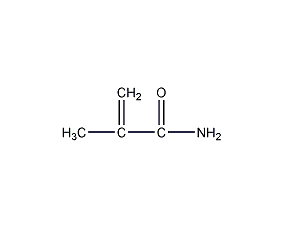
Structural formula
| Business number | 01PU |
|---|---|
| Molecular formula | C4H7NO |
| Molecular weight | 85.10 |
| label |
2-Methacrylamide, 2-MethylPropenamide, 2-Methylacrylamide, Methacrylic amide |
Numbering system
CAS number:79-39-0
MDL number:MFCD00008018
EINECS number:201-202-3
RTECS number:UC6475000
BRN number:605397
PubChem number:24882665
Physical property data
1. Properties: The pure product is white crystal, while the industrial product is slightly yellow.
2. Density (g/mL, 25/4℃): 1.115
3. Relative vapor density (g/mL, air=1): Uncertain
4. Melting point (ºC): 110~111
5. Boiling point (ºC, normal pressure): 215
6. Boiling point (ºC, 5.2kPa): Uncertain
7. Refractive index: Uncertain
8. Flash point (ºC): Uncertain
9. Specific rotation (º): Uncertain
10. Autoignition point or ignition temperature (ºC): Uncertain
11. Vapor pressure (kPa, 25ºC): Uncertain
12. Saturated vapor Pressure (kPa, 60ºC): Uncertain
13. Heat of combustion (KJ/mol): Uncertain
14. Critical temperature (ºC): Uncertain
15. Critical pressure (KPa): Uncertain
16. Log value of oil-water (octanol/water) partition coefficient: Uncertain
17. Explosion upper limit (%, V/V): Uncertain
18. Lower explosion limit (%, V/V): Uncertain
19. Solubility: Soluble in ethanol, methylene chloride, slightly soluble In ether and chloroform.
Toxicological data
1. Acute toxicity
Human inhalation LC50: 3mg/m3;
Rat caliber LD50: 459g/kg; Rat skin LD50: >6mg/kg;
p>
Mouse caliber LD50: 451mg/kg; mouse skin LD50: >6mg/kg;
Rat abdominal cavity LD50: 200mg/kg;
Rabbit skin LD50 : 650 uL/kg;
2. This product is toxic, one-tenth less toxic than acrylamide, but its vapor may cause central nervous system disorders after inhalation through the respiratory tract or absorption through the skin.
Ecological data
None yet
Molecular structure data
1. Molar refractive index: 23.71
2. Molar volume (cm3/mol): 90.2
3. Isotonic specific volume (90.2K ): 210.5
4. Surface tension (dyne/cm): 29.6
5. Polarizability (10-24cm3): 9.40
Compute chemical data
1. Reference value for hydrophobic parameter calculation (XlogP): 0.1
2. Number of hydrogen bond donors: 1
3. Number of hydrogen bond acceptors: 1
4. Number of rotatable chemical bonds: 1
5. Number of tautomers: 2
6. Topological molecule polar surface area 43.1
7. Number of heavy atoms: 6
8. Surface charge: 0
9. Complexity: 85.5
10. Number of isotope atoms: 0
11. Determine the number of atomic stereocenters: 0
12. Uncertain number of atomic stereocenters: 0
13. Determine the number of chemical bond stereocenters: 0
14. Number of uncertain chemical bond stereocenters: 0
15. Number of covalent bond units: 1
Properties and stability
1. This product is toxic, one-tenth less toxic than acrylamide, but its vapor may cause central nervous system disorders after inhalation and percutaneous absorption through the respiratory tract. Danger. During operation, masks and gas masks should be worn to prevent direct contact with
skin.
2. Exist in smoke.
Storage method
This product should be sealed and stored in a cool, dark place.
This product is packed in plastic bags to prevent heat and sun. It should be stored in a cool and ventilated place below 20℃. The shelf life is 6 months. Store and transport according to regulations on toxic substances.
Synthesis method
Using sodium cyanide as raw material and reacting with sulfuric acid to produce hydrocyanic acid, hydrocyanic acid reacts with acetone to form acetone cyanohydrin, reacts with concentrated sulfuric acid to form methacrylamide sulfate, and then neutralizes it with ammonia to produce The finished product methacrylamide is obtained. Hydrogen cyanide is produced by reacting sodium cyanide with sulfuric acid. Methacrylamide sulfate is prepared from hydrocyanic acid. The production method is the same as that of methacrylic acid. The obtained methacrylamide sulfate is neutralized with ammonia water, extracted, crystallized, filtered, and dried at low temperature to obtain the finished product. Using sodium cyanide as raw material to produce methacrylamide, each ton of product consumes 821kg of sodium cyanide, 883kg of acetone (≥98.5%), 3440kg of sulfuric acid, and 650kg of liquid ammonia.
Purpose
Methacrylamide is an intermediate in the production of methyl methacrylate.
Used in the production of methyl methacrylate. Used as fiber leveling agent, moisture absorbent, adhesive and antistatic agent.


